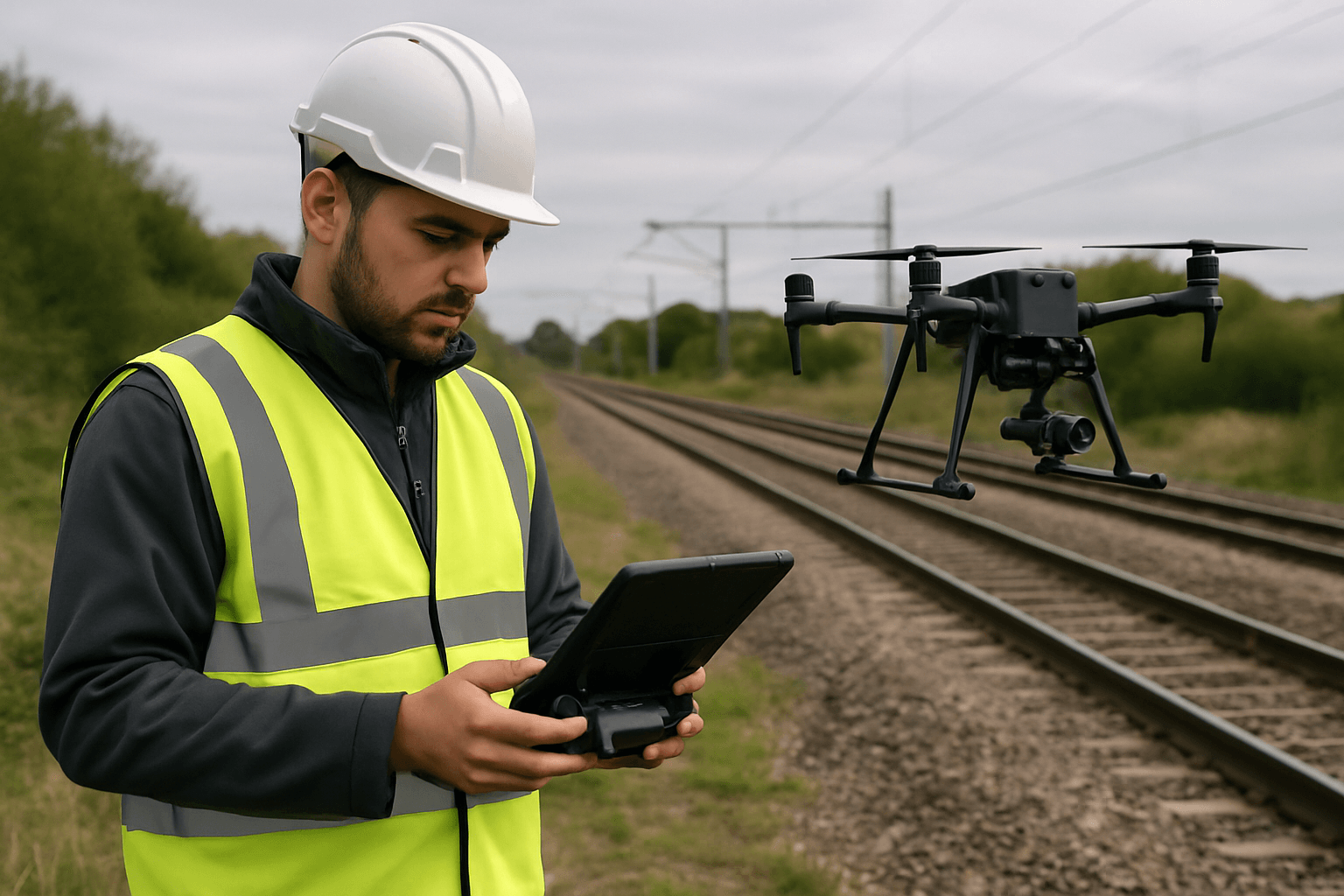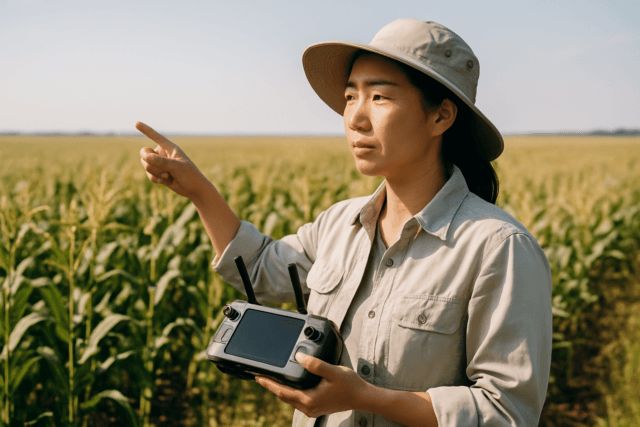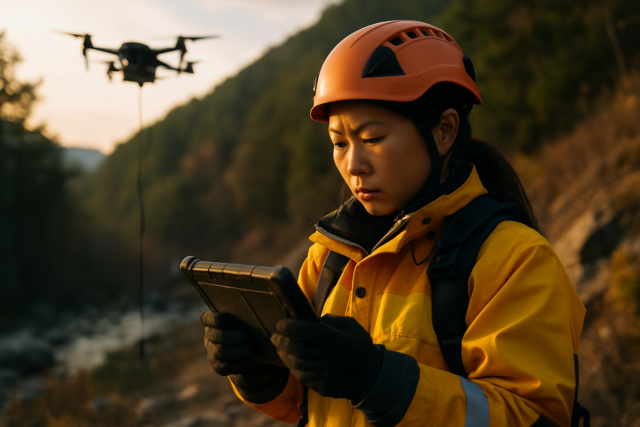Drones, also known as unmanned aerial vehicles (UAVs), have rapidly evolved from novel gadgets to indispensable tools across various sectors in the UK. Their capacity to gather real-time data, automate processes, and access previously unreachable locations is transforming operations and unlocking substantial cost savings for businesses.
Streamlining Operations and Reducing Labour Costs
One of the most significant ways drones save money is by streamlining operations and drastically reducing labour costs. Traditional methods of surveying, inspection, and data collection often require large teams, specialized equipment, and extensive time commitments. Drones, however, can accomplish these tasks with significantly less manpower and in a fraction of the time.
Land Surveying
Conventional land surveying can take days or even weeks, depending on the site’s size and terrain. Drones, on the other hand, can map large areas with high precision in just minutes, collecting thousands of data points in a single flight. This rapid data acquisition translates to faster project turnarounds and reduced downtime.
Construction Site Monitoring
Drones equipped with high-definition cameras and sensors can monitor construction sites, track materials, and assess inventory in real-time. This eliminates the need for manual inspections, reduces labour costs, and allows resources to be reallocated to other critical areas of the project.
Infrastructure Inspection
Inspecting bridges, power lines, and other critical infrastructure components traditionally involves costly and dangerous manned operations. Drones can access hard-to-reach locations, assess structural integrity, and provide real-time data without putting human lives at risk, while also reducing the need for expensive equipment like scaffolding and harnesses. For example, drone-based dam inspections can reduce costs by 40% to 60%.
Specific Examples of Drone Cost Savings
Construction
- Site Surveys and Mapping: Drones capture millions of data points, creating super-detailed site maps more accurately, safely, and cost-effectively than traditional methods. This leads to better planning and execution, saving time and money.
- Earthwork and Site Preparation: Drones provide precise measurements, leading to increased accuracy in earthwork and site preparation. This results in time savings, reduced over-excavation, and optimized material usage, ultimately reducing costs.
- Equipment and Materials Management: Drones streamline equipment and materials management by conducting quick inventory counts, tracking equipment, verifying deliveries, and deterring theft through regular aerial surveillance. This leads to improved accuracy, better planning, less waste, and increased productivity.
- Project Monitoring: Drones reduce project monitoring costs by up to 55%, enabling faster progress tracking and immediate adjustments. This ensures projects stay on track and within budget.
- Improved Communication: Drones can streamline communications, provide accurate material estimates, and connect clients to job sites. Aerial imagery and data can be easily integrated into documents, providing a clear and concise record of progress.
- Safety: Threatening accidents on construction sites monitored by drones decreased by up to 91 percent.
Agriculture
- Crop Monitoring: Drones equipped with high-resolution cameras and sensors can monitor crops, identify diseases, and assess crop health over large areas in a fraction of the time it would take humans. This increased efficiency allows farmers to save valuable time and resources, ultimately leading to improved productivity.
- Precision Farming: Agricultural drones are now more cost-effective than traditional machinery for many farmers. With larger payloads and the ability to operate in difficult terrain, drones can apply treatments more efficiently and effectively.
- Reduced Chemical Usage: Drones can reduce chemical usage by up to 40% and increase yields by up to 20% in agriculture by providing data on crop health, irrigation needs, and pest management.
- Spraying Drones: Rantizo, a drone spraying service provider, believes spraying drones contribute to a much-quicker ROI when compared to other spraying methods since “it’s not a $500,000-or-more investment.” According to the company, investment in a spraying drone and flying certification comes in at around $40,000-$50,0000.
Infrastructure
- Bridge Inspections: Drone-based inspections offer significant indirect benefits, including cost savings from enhanced safety. For example, drones reduce reliance on costly safety equipment like harnesses and scaffolding. Drones also lower the risk of injuries or fatalities, which are more common in traditional methods due to hazardous conditions, fatigue, and extended work hours.
- Power Line Inspections: A single drone can inspect 15-20 miles of power lines per day, compared to just 1-2 miles with traditional ground-based crews.
- Pipeline and Bridge Inspections: Cost reductions of 25-30% while ensuring compliance with safety and environmental standards.
Environmental Monitoring
- Ecosystem Surveys: Drones reduce costs for environmental surveys by 30-50% and allow for faster data collection on ecosystems, wildlife populations, and habitat changes—all without disrupting the environment.
Other Industries
- Utilities and Energy: Drones offer industry-specific benefits for utilities and energy companies, such as efficient inspection of power lines and infrastructure.
- Civil Engineering: Civil engineering firms benefit from cost reductions in pipeline and bridge inspections, ensuring compliance with safety and environmental standards.
- Logistics: Logistics companies utilize drone technology for last-mile deliveries, drastically reducing delivery times and costs. A McKinsey report estimates that a 40% savings in delivery costs could translate into a 15-20% increase in profit margin and a resulting 15-20% price decrease.
- Forest Regeneration Monitoring: Drones offer a potentially more cost-effective and detailed approach compared to traditional methods. The long-term cost-effectiveness for drone forest regeneration monitoring hinges on the initial investment in drone technology, which must be weighed against the recurring expenditures associated with conventional monitoring practices.
Quantifying Drone Cost Savings: ROI
To accurately assess the financial benefits of drone integration, businesses should calculate the Return on Investment (ROI). ROI measures the profitability or value gained from using drones compared to the initial and ongoing costs.
Factors That Influence Drone ROI:
- Purchase and Setup Costs: High-end drones for industrial applications cost more but can deliver significant ROI. Initial costs typically include the drone purchase (ranging from £24,000 to £160,000), accessories, and specialized software for processing and analyzing the captured data.
- Labour and Time Savings: Drones replace costly tasks like manual inspections, land surveys, and crop analysis. For example, a drone survey that takes 2 hours may replace a team working for 2 days.
- Revenue Generation: Drones can directly generate income through photography, mapping, deliveries, or inspections.
- Operational Efficiency: Faster data collection and improved accuracy lead to better decision-making.
- Maintenance and Downtime: Proper care ensures long-term ROI by avoiding costly breakdowns.
Calculating ROI:
- Determine the initial investment: Include equipment, software, and training costs.
- Estimate the annual cost savings: Include reduced labor, improved efficiency, and decreased maintenance costs.
- Calculate the annual revenue generated: Include increased crop yields, more efficient construction projects, or higher property sales.
- Subtract the initial investment and annual costs from the annual revenue.
- Divide the result by the initial investment to obtain the ROI.
For example, if a drone reduces labour costs by £4,000 annually but costs £2,400 upfront, the ROI would quickly justify the investment.
Maximizing Drone ROI
To maximize ROI with drone services, businesses must:
- Choose the Right Drone: Match drone capabilities to your business goals (e.g., LiDAR for mapping, thermal cameras for inspections).
- Optimize Workflows: Integrate drones into existing workflows to maximize savings and efficiency.
- Minimize Operational Costs: Proper maintenance, energy-efficient batteries, and skilled operators reduce expenses.
- Leverage Data: Use drone-captured data for actionable insights that save costs or increase output.
- Track Metrics Over Time: Regularly monitor drone-related costs and savings to refine ROI calculations.
Challenges and Considerations
While the cost-saving potential of drones is substantial, businesses should also consider the challenges and potential limitations:
- Regulatory Framework: Navigating the evolving regulatory landscape for drone operations is crucial for ensuring compliance and avoiding penalties.
- Technological Advancements: Staying abreast of the latest technological advancements in drone technology is essential for maximizing efficiency and ROI.
- Data Processing and Analysis: Ensuring efficient data processing and analysis techniques are in place to handle the increasing volume of data generated by drones is critical.
The Future of Drone Cost Savings
As technology advances and regulations become more streamlined, the cost savings associated with drone technology are expected to increase further. Automation of battery and payload management, for example, could lead to a 90% reduction in field application costs for farmers.
Conclusion
Drones offer immense potential for UK businesses seeking to improve their operations and maximize ROI. By carefully considering the factors outlined above and continuously optimizing their operations, businesses can harness the power of drone technology to drive growth and success.





